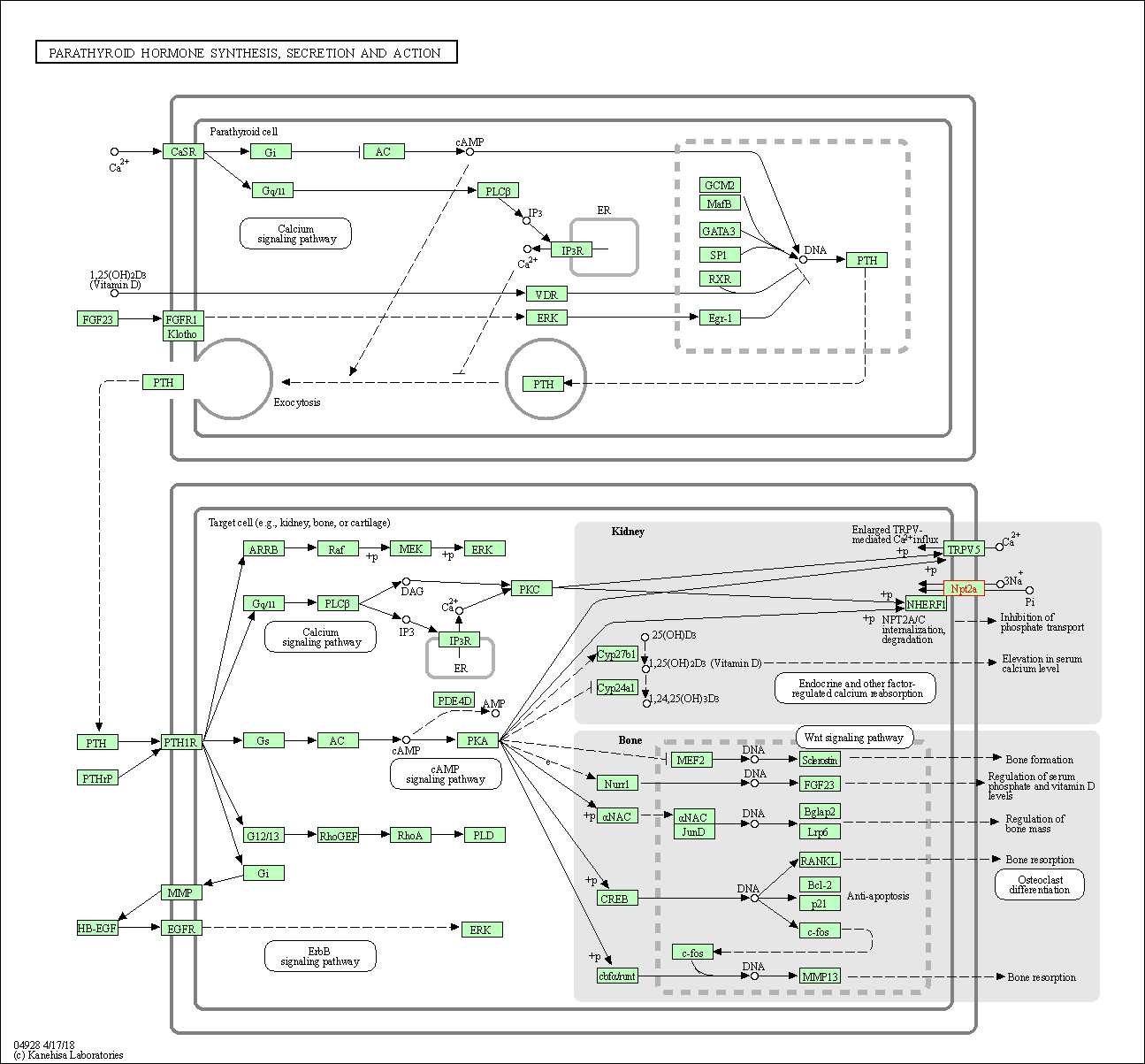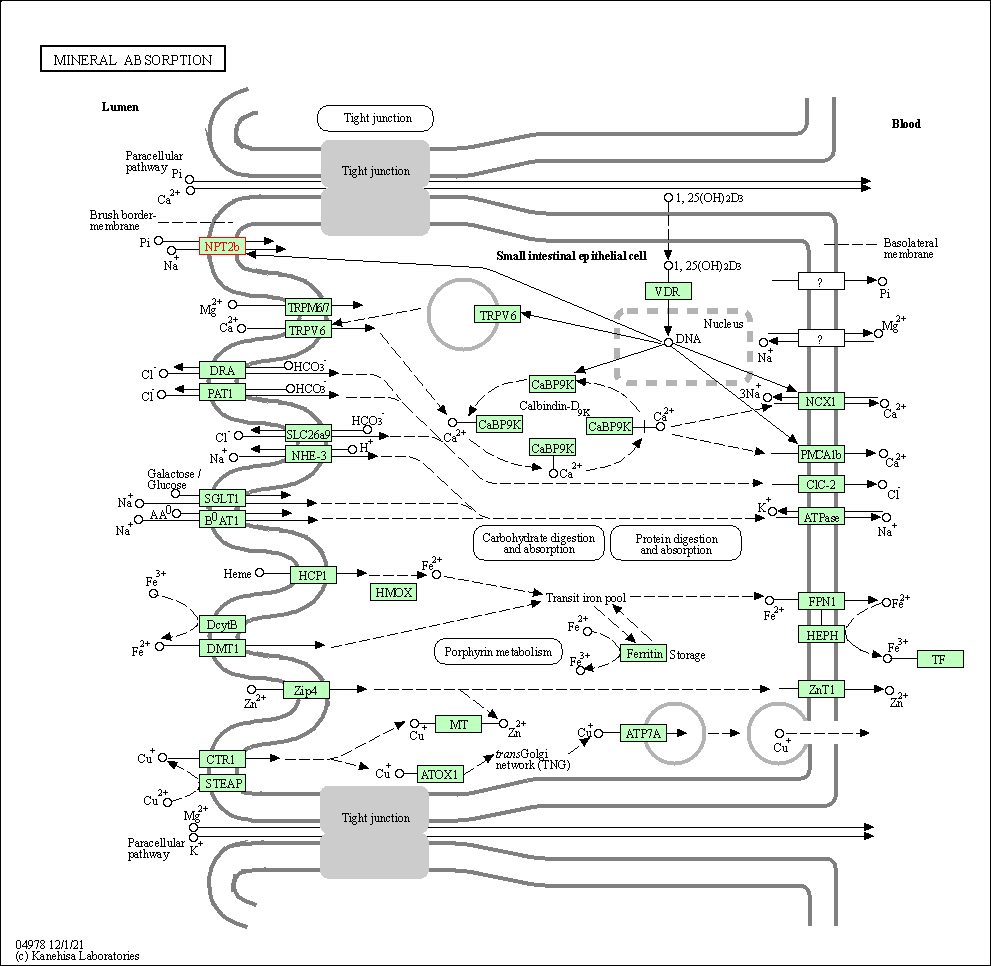Target Information
| Target General Information | Top | |||||
|---|---|---|---|---|---|---|
| Target ID |
T98798
(Former ID: TTDI02138)
|
|||||
| Target Name |
Sodium/phosphate cotransporter 2B (SLC34A2)
|
|||||
| Synonyms |
Solute carrier family 34 member 2; Sodium-phosphate transport protein 2B; Sodium-dependent phosphate transport protein 2B; NaPi3b; NaPi-2b; Na(+)/Pi cotransporter 2B; Na(+)-dependent phosphate cotransporter 2B
Click to Show/Hide
|
|||||
| Gene Name |
SLC34A2
|
|||||
| Target Type |
Clinical trial target
|
[1] | ||||
| Disease | [+] 1 Target-related Diseases | + | ||||
| 1 | Ovarian cancer [ICD-11: 2C73] | |||||
| Function |
It may be the main phosphate transport protein in the intestinal brush border membrane. May have a role in the synthesis of surfactant in lungs' alveoli. May be involved in actively transporting phosphate into cells via Na(+) cotransport.
Click to Show/Hide
|
|||||
| BioChemical Class |
Phosphate:sodium symporter
|
|||||
| UniProt ID | ||||||
| Sequence |
MAPWPELGDAQPNPDKYLEGAAGQQPTAPDKSKETNKTDNTEAPVTKIELLPSYSTATLI
DEPTEVDDPWNLPTLQDSGIKWSERDTKGKILCFFQGIGRLILLLGFLYFFVCSLDILSS AFQLVGGKMAGQFFSNSSIMSNPLLGLVIGVLVTVLVQSSSTSTSIVVSMVSSSLLTVRA AIPIIMGANIGTSITNTIVALMQVGDRSEFRRAFAGATVHDFFNWLSVLVLLPVEVATHY LEIITQLIVESFHFKNGEDAPDLLKVITKPFTKLIVQLDKKVISQIAMNDEKAKNKSLVK IWCKTFTNKTQINVTVPSTANCTSPSLCWTDGIQNWTMKNVTYKENIAKCQHIFVNFHLP DLAVGTILLILSLLVLCGCLIMIVKILGSVLKGQVATVIKKTINTDFPFPFAWLTGYLAI LVGAGMTFIVQSSSVFTSALTPLIGIGVITIERAYPLTLGSNIGTTTTAILAALASPGNA LRSSLQIALCHFFFNISGILLWYPIPFTRLPIRMAKGLGNISAKYRWFAVFYLIIFFFLI PLTVFGLSLAGWRVLVGVGVPVVFIIILVLCLRLLQSRCPRVLPKKLQNWNFLPLWMRSL KPWDAVVSKFTGCFQMRCCCCCRVCCRACCLLCDCPKCCRCSKCCEDLEEAQEGQDVPVK APETFDNITISREAQGEVPASDSKTECTAL Click to Show/Hide
|
|||||
| 3D Structure | Click to Show 3D Structure of This Target | AlphaFold | ||||
| Drugs and Modes of Action | Top | |||||
|---|---|---|---|---|---|---|
| Clinical Trial Drug(s) | [+] 2 Clinical Trial Drugs | + | ||||
| 1 | Upifitamab rilsodotin | Drug Info | Phase 3 | Ovarian cancer | [2] | |
| 2 | XMT-1592 | Drug Info | Phase 1/2 | Non-small-cell lung cancer | [3] | |
| Cell-based Target Expression Variations | Top | |||||
|---|---|---|---|---|---|---|
| Cell-based Target Expression Variations | ||||||
| Different Human System Profiles of Target | Top |
|---|---|
|
Human Similarity Proteins
of target is determined by comparing the sequence similarity of all human proteins with the target based on BLAST. The similarity proteins for a target are defined as the proteins with E-value < 0.005 and outside the protein families of the target.
A target that has fewer human similarity proteins outside its family is commonly regarded to possess a greater capacity to avoid undesired interactions and thus increase the possibility of finding successful drugs
(Brief Bioinform, 21: 649-662, 2020).
Human Tissue Distribution
of target is determined from a proteomics study that quantified more than 12,000 genes across 32 normal human tissues. Tissue Specificity (TS) score was used to define the enrichment of target across tissues.
The distribution of targets among different tissues or organs need to be taken into consideration when assessing the target druggability, as it is generally accepted that the wider the target distribution, the greater the concern over potential adverse effects
(Nat Rev Drug Discov, 20: 64-81, 2021).
Human Pathway Affiliation
of target is determined by the life-essential pathways provided on KEGG database. The target-affiliated pathways were defined based on the following two criteria (a) the pathways of the studied target should be life-essential for both healthy individuals and patients, and (b) the studied target should occupy an upstream position in the pathways and therefore had the ability to regulate biological function.
Targets involved in a fewer pathways have greater likelihood to be successfully developed, while those associated with more human pathways increase the chance of undesirable interferences with other human processes
(Pharmacol Rev, 58: 259-279, 2006).
Human Similarity Proteins
Human Tissue Distribution
Human Pathway Affiliation
|
|
|
There is no similarity protein (E value < 0.005) for this target
|
|
Note:
If a protein has TS (tissue specficity) scores at least in one tissue >= 2.5, this protein is called tissue-enriched (including tissue-enriched-but-not-specific and tissue-specific). In the plots, the vertical lines are at thresholds 2.5 and 4.
|
| KEGG Pathway | Pathway ID | Affiliated Target | Pathway Map |
|---|---|---|---|
| Parathyroid hormone synthesis, secretion and action | hsa04928 | Affiliated Target |

|
| Class: Organismal Systems => Endocrine system | Pathway Hierarchy | ||
| Mineral absorption | hsa04978 | Affiliated Target |

|
| Class: Organismal Systems => Digestive system | Pathway Hierarchy | ||
| Chemical Structure based Activity Landscape of Target | Top |
|---|---|
| Target Poor or Non Binders | Top | |||||
|---|---|---|---|---|---|---|
| Target Poor or Non Binders | ||||||
| Target Regulators | Top | |||||
|---|---|---|---|---|---|---|
| Target-regulating microRNAs | ||||||
| References | Top | |||||
|---|---|---|---|---|---|---|
| REF 1 | Solute carrier family 34 member 2 overexpression contributes to tumor growth and poor patient survival in colorectal cancer. Biomed Pharmacother. 2018 Mar;99:645-654. | |||||
| REF 2 | ClinicalTrials.gov (NCT05329545) A Phase 3, Randomized, Double-blind, Placebo-controlled, Multicenter Study of Upifitamab Rilsodotin (XMT-1536) as Post-Platinum Maintenance Therapy for Participants With Recurrent, Platinum-Sensitive, Ovarian Cancer (UP-NEXT). U.S.National Institutes of Health. | |||||
| REF 3 | ClinicalTrials.gov (NCT04396340) First-in-Human Study of XMT-1592 in Patients With Ovarian Cancer and NSCLC Likely to Express NaPi2b. U.S. National Institutes of Health. | |||||
| REF 4 | Clinical pipeline report, company report or official report of Mersana Therapeutics | |||||
| REF 5 | Clinical pipeline report, company report or official report of Mersana Therapeutics. | |||||
If You Find Any Error in Data or Bug in Web Service, Please Kindly Report It to Dr. Zhou and Dr. Zhang.

